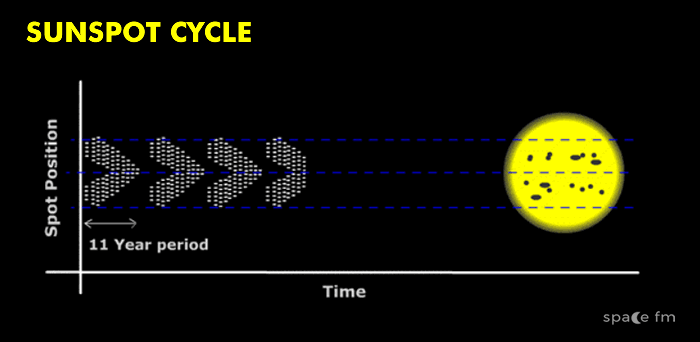Sunspots
10.6 - Understand the structure, origin and evolution of sunspots10.8 - Be able to use sunspot data relating to the solar cycle
Sunspots are areas on the photosphere of the Sun that are cooler than the surrounding area and so appear darker.
Characteristics
Usually they travel around the Sun's disc in groups across roughly 1/3 of the surface between 40º north and 40º south of the Equator.
They consist of a central region called an umbra and a surrounding area called a penumbra. The umbra is the darker region, the penumbra surrounds it. Note that these terms are similar to those used in the eclipse section.
Temperatures of the umbra are typically 4,000k. The penumbra is usually around 5,600k. Typically they vary from a few thousand miles to 50,000km. Exceptionally large sunspots have been observed around 200,000km.
Evolution
Sunspots are caused by local changes in the Sun's magnetic field. They start when coronal loops that eject from the sun are drawn back again and become 'wound up' as different parts of the sun rotate at different rates. When this happens, they build up and create prominences, and even sometimes flares. The chromosphere on the surface gets 'punctured', decreasing the temperature in that area for a time.
Their duration may vary from several hours to months. Sunspots contract and expand as they move until eventually, they decay.
Rotation
The rotation of the Sun can be observed by of the movement of sunspots across its disc. See the next page on Rotation.Sunspot Cycle
Sunspots are good evidence of a solar cycle which the Sun goes through every 11 years.
This can be visualised using a butterfly diagram. The more sunspots occur, the more heat the Sun produces and vice versa. More sunspots mean the Sun is active, less mean the Sun is quiet.
Animation
Summary
- Darker part of sunspot = Umbra
- Lighter part of sunspot = Penumbra
- Sunspot cycle = 11 years
Questions
- Why does a sunspot look darker than the rest of the Sun?
- Describe the long-term drift of sunspots.
- Describe the sunspot Cycle.
Did you know?
A period of low sunspot activity in the 17th century coincided with a cold period in northern Europe. This was known as the Maunder Minimum.
Links
- Exploratorium Introduction to sunspots
- Earth Observatory Sunspot information
- Space Weather Up to date solar activity information including a sunspot number
- Solar Max Sunspot Cycle Information
- SOHO Sunspots



 | © All Rights Reserved |
| © All Rights Reserved |